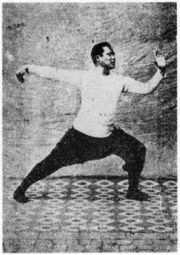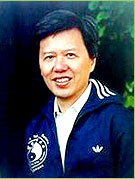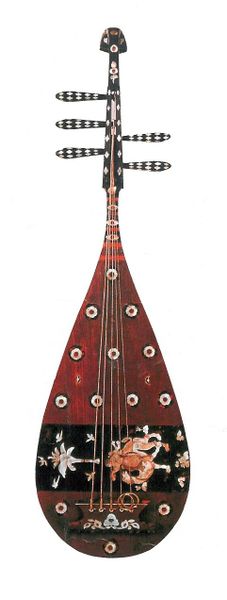The Taoist Tai Chi 108-Move Set
Important: In February 2007, the Powers That Be of the Taoist Tai Chi Society stumbled across
an early version of this page that did not work properly. They became upset with the frivolous
nicknames I have given to some of the moves. (If you're into TTC, can you recognize "Rush Hour
Pizzeria"?) The moment I learned the page did not work properly, I hid it. A month after I hid it,
TTCS-USA demanded that I dismantle my entire web site. Because that's never going to
happen, TTCS-USA has decreed that I am "persona non grata" — I may not even be a set
leader, much less contribute my professional expertise to benefit my local branch.
If you are a student of Taoist tai chi who has stumbled across this page by accident, beware.
They're very likely to want to punish you, too, for daring to read it.
— Mary W. Matthews
The Taoist Tai Chi 108-Move Set
Many historians believe that Tai Chi originated with the ninth-century Taoist philosopher
Li Daotzu (or Li Tao-Tzu), who defined the first 37 moves in a book called The Earlier Heaven
Movements. Two centuries later, according to legend, Zhang San Feng (or Cheung San-feng),
another priest in a Shaolin Temple in China, morphed the earlier philosophy into a system of
self-defense, Tai Chi Chuan.
 Yang Cheng-fu was the best-known teacher of tai chi in history, and he was among the
first to offer instruction in tai chi to the general public. This is a 1918 photo of him
performing "Single Whip."
Yang Cheng-fu was the best-known teacher of tai chi in history, and he was among the
first to offer instruction in tai chi to the general public. This is a 1918 photo of him
performing "Single Whip." |
Today there are five principle "schools"
of Tai Chi Chuan: Chen, Yang, Hao, Sun and Wu.
According to the Wikipedia article, it is believed that Chen Wangting originated
Chen-style tai chi in the mid-1600s. It was taught by the Chen family to the Yang
family starting in 1820. (Yang Chengfu (1888-1936) is responsible for standardizing
and popularizing Yang-style tai chi.) In the mid-19th century, Yang Pan-hou taught
tai chi to Wu Chuan-yu, who founded both Hao (Wu) and Sun styles. Wu Chien-chuan
(1870-1942) founded the Wu school around the turn of the 20th century. The Yang
family tai chi website says that Yang is the most popular style of tai chi practiced
today — but only Taoist Tai Chi is nonprofit and therefore tax-deductible.
All of them can be traced back to a single man, Chen Wang Ting, a general of the latter years
of the Ming Dynasty, who in the years immediately after 1644 created seven sets, only two of
which have survived to the present day.
Taoist Tai Chi, which originated in the Yang school, was developed by Master Moy Lin-Shin
(Mei Lianxian; 1931-98) around 1970. Master Moy was a sickly child, and it has been said that
when he was ten, his parents took him to a monastery in Guangdong and told the monks he was
dying — and through the Earlier Heaven Wu-chi sect of the Hua Shan School of Taoism, he
regained his health. Around 1950, Master Moy became a Shaolin monk himself, and in 1968, with
two others, he founded the Fung Loy Kok Institute of Taoism.
(The Wikipedia biography of Master Moy
is quite interesting.) One of the leading members of the St. Petersburg, FL branch of the
Taoist Tai Chi Society says that Master Moy invented Taoist Tai Chi because he felt that his
true interest, Lok Hup Ba Fa, was too difficult for most students; he himself had spent two
years learning the first two moves well enough for his instructor to allow him to continue.
 Master Moy Lin-Shin
Master Moy Lin-Shin |
Although tai chi was originally a martial art, Taoist Tai Chi was called "moving
meditation" by Master Moy. It is a system of slow, gentle, graceful movements aimed at
the promotion and restoration of health. It improves balance, circulation, and coordination
and such conditions as rheumatoid arthritis, and many older students have volunteered (in
my hearing) that their doctors have told them they have regained lost inches of height.
Medical studies have concluded that the regular practice of tai chi
promotes longevity.
In 1995, Chris Van Fleet wrote, "As I move into my fifth year of [Taoist] tai chi practice,
the changes in my body provide a constant source of joy, peace, and discovery that I have
never before known. For me, this sensation is a glimmer of perfect order, tenderness, perhaps
divinity itself. While my physical awareness for the time being seems to be moving inward,
the spiritual growth that comes from a greater sense of harmony and connection with others
keeps expanding."
If the full 108-move Taoist Tai Chi "set" were music, it would consist of
three to six movements. "Appear to Close Entrance / Cross Hands" is done three
times, and so one could consider three movements: 1-17, the warm-up (allegro - about two minutes,
not including the bow); 18-55 (scherzo - about five minutes); and
56-108 (allegro - about six minutes, plus about 10 seconds for
the final bow).
That's one way to look at it. Here's another: Moves 21 through 36 and moves 78 through 92 are identical except for
the number of "Cloud Hands"; I call them "Monkey Pats Pony (5)"
and "Monkey Pats
Pony (3)."
Moves 21-36 and 78-92 are identical except for the number of "Cloud Hands"
(five and three, respectively). Alert students of tai chi will have noticed
long ago that there are only two differences: (1) "Turn and Chop With Fist" is called
by its presumably ancient name, "White Snake Turns and Puts Out Tongue"; and
(2) every list in the world of the 108 movements of Taoist tai chi
acknowledges only two "Repel Monkeys," even though three are done in reality.
If you go back and look in the Holy Book, you will see
quite clearly that Move 79 consists of TWO "Repel Monkeys."
Why were Moves
21, 22, and 23 folded into Moves 78 and 79? I'll bet if you asked the
leadership of TTCS, they would mumble something and quickly change the
subject. Here's MY guess: 108 is a "holy number" in several religions,
including Hinduism and Buddhism, and it is an important number in
Chinese martial arts (including karate, wing chun, kuk sool wong,
and tai chi) and Chinese medicine. 109 is the 29th prime number and
the number of JFK's PT boat, but it has no special significance in either
religion or the martial arts. So, faced with a 109-move set, Master Moy
folded two "Repel Monkeys" into one so that the set would be 108 moves.
Moves 37 through 55 we call "Wobblefest." So another way of thinking about the
Taoist Tai Chi "movements" is: (A - allegro:) Warm-Up; (B - andante:) Monkey Pats
Pony (5); (C - scherzo:) Wobblefest;
Horsies Stomp Chicken ; ;
| Horsies Stomp Chicken |
(hide)
|
This section begins with move 56, the second "Carry Tiger," and proceeds through the
horsies ("Rush Hour Pizzeria"), the ladies ("Fair Lady Closes Storm Shutters"), to move
78, the second "Golden Cock Stands on One Leg."
(D - andante:) Monkey Pats Pony (3);
and (E - allegro:) the Final 16.
(The musical analogy should not be taken literally, of course. All tai chi is adagio.)
* * * Skip ahead to table * * *
Note: I created this page early in 2007. Several months later, the president of my branch
notified me that the TTCS Powers That Be were upset by it — despite the page's absolute
factuality, and indeed its respect bordering on worship for Master Moy. I immediately hid the
page. If you are reading these words, it is because you searched for the page.
As I understand it, someone at TTCS-USA stumbled across the page before it was hidden, and,
AS I UNDERSTAND IT, the elderly Chinese men of Orangeville are upset by the "disrespect" I
show by having the gall to nickname some of the moves. Oh, the horror! Jane Edwards, the
president of TTCS-USA, wrote to me in March 2007 and explained that Master Moy would have disapproved of
my nicknaming any moves in the set. I wrote Ms. Edwards quite a long reply, noting (a) this
page has been hidden from the public since late February 2007; (b) the "disrespectful" nicknames
can be seen only if one hovers one's cursor over the linking text, making them doubly hidden;
and (c) her claim that Master Moy chose such names as "White Snake Turns and Puts Out Tongue" to make
the name "simple" was ludicrous. Exactly how is "Parting the Wild Horse's Mane" a simpler
name than "Rush Hour Pizzeria"? Especially given that horses are a good deal taller today than
they were in the ninth century, and that virtually no one in the world is likely to even see a wild horse, much less get close enough to part her mane?
Ms. Edwards' whole reply to my reply was to demand that I
dismantle my ENTIRE WEB SITE.
But that's not the end of the matter! Because of the last illness and lingering death of my
mother, I have not been able to return to this page until now (March 2008). I was notified a
few days ago that it is wholly proper for TTCS-USA to arrogantly demand that I dismantle my
ENTIRE WEB SITE, but that my refusal to do so makes ME guilty of "impropriety." Until I dismantle
my ENTIRE WEB SITE, I am "persona non grata" — I may not even be a set leader! It is the
opinion of the president of my local branch that not even a groveling apology from me for MY
"impropriety" will assuage the righteous wrath of Orangeville.
Well, bleep you, TTCS-USA. If my refusing to obey your outrageously arrogant and improper
demand is a crime for which I must be punished, it's your loss. It bewilders me
that I may not even contribute my professional expertise (which is considerable) to my local
branch, for fear of the branch's being punished too — solely for the existence of one
page on the Internet that is HIDDEN from the general public, whose "offensive" material
is doubly hidden, that is factually accurate, and that is almost worshipful of Master Moy!
I can't tell you how sad
it makes me that my local Powers That Be are so "whipped" by TTCS-USA's elite they
won't even let me contribute to my local branch under a different name
— and all for reasons that seem to me both nonsensically picayune and outrageously arrogant.
(Hover your cursor over differently-colored text for commentary.)
Warm-Up: The First 17 Moves
(Opening to Appear to Close Entrance (and Cross Hands)) |
 |
A Tang Pei Pa (or Pipa)
(pronounced "pay, Pa") |
- Opening of Tai Chi
- Left Grasp Bird's Tail
- Grasp Bird's Tail
- White Stork Spreads Wings
- Brush Knee (left)
-
- Brush Knee and Twist Step (left)
- Brush Knee and Twist Step (right)
- Brush Knee (left)
-
- Brush Knee and Twist Step (left)
- Chop with Fist
- Step Up, Deflect, Parry, Punch
-
- Cross Hands
|
First Carry Tiger, Diagonal "Single Whip," and Fist Under Elbow |
- Carry Tiger to Mountain
-
-
|
|
- Go Back to Ward Off Monkey (right)
- Go Back to Ward Off Monkey (left)
-
- Step Up and Raise Hands
- White Stork Spreads Wings
- Brush Knee (left)
-
-
- Turn and Chop with Fist
- Step Up, Deflect, Parry, Punch
- Step Up to Grasp Bird's Tail
- Single Whip
-
- Single Whip
|
|
- to Right
- to Left
- Turn and Kick
- Brush Knee and Twist Step (left)
- Brush Knee and Twist Step (right)
-
- Turn and Chop with Fist
- Step Up, Deflect, Parry, Punch
- Hit Tiger at Left
- Hit Tiger at Right
- Right Foot Kick
-
- Left Foot Kick
- Turn and Kick
- Chop with Fist
- Step Up, Deflect, Parry, Punch
-
- Cross Hands
|
Horsies Stomp Chicken |
- Carry Tiger to Mountain
-
-
- Parting Wild Horse's Mane (left)
- Parting Wild Horse's Mane (right)
- Parting Wild Horse's Mane (left)
- Parting Wild Horse's Mane (right)
- Left Grasp Bird's Tail
- Step Up to Grasp Bird's Tail
- Single Whip
-
- Fair Lady Works Shuttles (right)
- Fair Lady Works Shuttles (left)
- Fair Lady Works Shuttles (right)
- Left Grasp Bird's Tail
- Step Up to Grasp Bird's Tail
- Single Whip
- Move Hands Like Clouds (seven times)
- Single Whip
-
- Golden Cock Stands on One Leg (left)
- Golden Cock Stands on One Leg (right)
|
Monkey Pats Pony (3) |
- Flying at a Slant
- Step Up and Raise Hands
- White Stork Spreads Wings
- Brush Knee (left)
- Push Needle to Sea Bottom
- Fan Penetrates through the Back
- Step Up, Deflect, Parry, Punch
- Step Up to Grasp Bird's Tail
- Single Whip
- Move Hands Like Clouds (three times)
- Single Whip
|
The Grand Finale (Final 16 Moves) |
-
- Turn and Kick
- Chop with Fist
- Brush Knee and Punch
- Step Up to Grasp Bird's Tail
- Single Whip
- Creeping Low Like a Snake
-
-
-
-
- Chop with Fist
- Step Up, Deflect, Parry, Punch
-
- Cross Hands
- Closing of Tai Chi
|
|